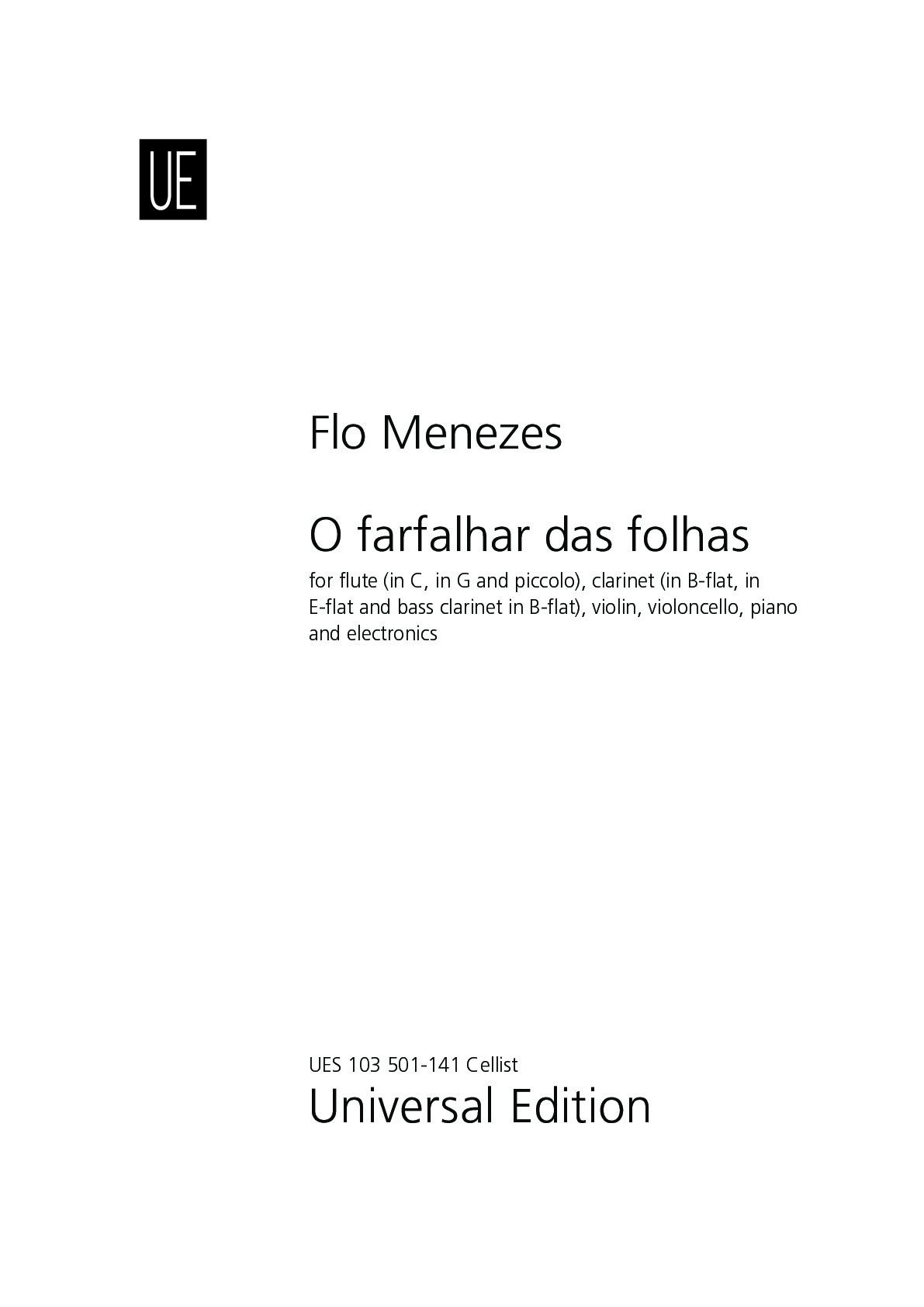.png)
Digital edition
immediately available as PDF
€14.95
Payments:
Shipping:
Flo Menezes
Violoncello (O farfalhar das folhas)
UES103501-141
Type: Stimme
Format: 210 x 297 mm
Pages: 12
Digital edition
immediately available as PDF
€14.95
Payments:
Shipping:
Audio preview
Description
O farfalhar das folhas (The rustling of leaves), written between February and April 2010 and realized at Studio PANaroma of Electroacoustic Music at Unesp (São Paulo State University), consists of a tribute to the memory of my brother, the great poet and theorist Philadelpho Menezes, who died exactly ten years ago, and who in 2010 would be reaching his fiftieth birthday. One of his most inventive ventures – perhaps his greatest poem – is unusually inserted at the edge of a poetry catalog, like the slides of a cartoon that, read in the opposite direction to the usual handling of a book, reveals itself at the same time as insecure and uncertain, as an imponderable intrusion in the printed catalog. When reading this poem, which Philadelpho classified as intersignic – in a radical intersemiosis between the visual, verbal and sound aspects of the poem –, we are reminded of the image of an insect (inseto = insect; inseRto = inserted; inCerto = uncertain) struggling against a glass that imprisons it. The sound of an /r/ emerges from this handling, as an uncertain phonemic insert amidst the word insect itself, while the revealing phrase: “O inserto bate as asas contra as leis da escrita” (“The insert/the uncertain beats its wings against the laws of writing”). This work does not set in music the poem, but is based on it in intersignic relation.
It is the poet himself who asserts: “[The poem] must be handled by flipping quickly backwards through the catalog with the tips of the fingers, as if the pages were the slides of a cartoon. The movement will order [its] Alexandrian verse. The rustling of the leaves enters as an information that, at first hearing, is a simple noise against the reading of the sentence, but that, afterwards, is the insect itself in despair against the deceptive transparency of the glass that is materialized by the intersignic decipherment” (in: “Uma abordagem tipológica da Poesia Visual”, I Mostra Internacional de Poesia Visual de São Paulo [“A Typological Approach Towards Visual Poetry”, I International Exhibition of Visual Poetry of São Paulo], 1988, p. 19).
O farfalhar das folhas, a sine littera work in which the poem inhabits the same space as the musicians without literally being “musicalized”, deals with three human states, continuously moving, but not always in an unequivocally linear way, to the last of them, the greatest of human yearnings: restriction (or constraints), the libertarian act and, finally, freedom. To these three states, the work associates, respectively, textures of micro-articulation, durative expansion (extended durations) and resonances in free itineraries, to which basically correspond three forms of sound processing, performed in real time: shuffling with distortions by ring modulation; time-stretching; and synthesis controlled in real time by the musicians themselves.
In the longing, as utopian as it is necessary, for freedom, the imponderable is unexpectedly inserted and struggles against the constraints given by the conditioning of our own writings. Quantum claustrophobics limit gestures in space-time (compressed intervals and rhythmic values, fragmentary interceptions). The libertarian act tends toward expansion: an insect that, becoming free of the misleading transparence of that glass arresting it, rediscovers an infinite time and space. And it is only in this way that one enjoys the many resonances and correspondences that unfold freely through the air, no longer as a free insect, but rather as if they were butterflies, colorful, tracing interesting trajectories in space.
In fact, the piece had been commissioned by the Sond’Ar-Te Electric Ensemble of Lisbon (where it had its pre-release) to be premiered at the City of London Festival in September 2010, where, in an act in favor of ecology and the defense of the environment, thousands of bees would be released into the air… And the latest in real-time electronics processing refers precisely to this free flight of the bees: sinusoidal sounds that cluster around a polarized musical note and then break free in random trajectories through space.
And in this process, that initial restrictive state already corresponds to all freedom, for the very noise of the insect that struggled against the glass is associated with the free wind that rustles the leaves of a libertarian forest, in the midst of which all difference will make sense, for, as Ezra Pound said, “the human beings differ from another as the leaves of trees” (A arte da poesia. São Paulo: Edusp / Editora Cultrix, 1976, p. 58).
More information
Type: Stimme
Format: 210 x 297 mm
Pages: 12

